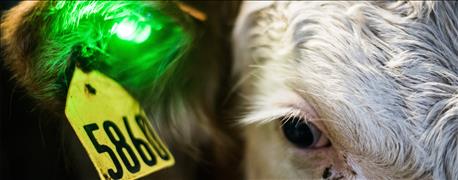
You've probably heard of the "Internet of Things" — the interconnectedness of electronics, software and sensors that together let them connect to each other, send and receive data with a central point. How about the Internet of Cows?
"There's definitely a need in agriculture for the Internet of Things, specifically when we look at livestock," says Vishal Singh, president and CEO at Quantified Ag. "It works well for livestock because you have a lot of data points, meaning individual animals, and it can all be sent to one place, and turn it into meaningful information that cattle producers can use in their day-to-day decisions."
That's exactly what Singh and Quantified Ag are hoping to accomplish using electronic identification ear tags for feedlot and backgrounder health management. Cattle can't tell us when they're sick, and until now, pen riders have had to rely on visual identification to detect sick cattle early on.
And Singh notes that's tough to do. "Cattle try to hide their symptoms, so by the time pen riders identify the illness, it's often late in the illness," he says. "In the case of bovine respiratory disease [BRD], which is the biggest problem in the feedyard, if you don't detect it early on, those animals develop lesions on their lungs, and they never grow like a healthy animal does. They lose two-tenths of a pound of growth efficiency per day. Those animals will never recover from it once they get those lesions on their lungs."

The Quantified Ag team includes Colton Franco (left), software engineer; Brian Schupbach, chief technology officer; Alex Heine, business development manager; and Vishal Singh, president and CEO. Not pictured is Andrew Uden, chief operations officer.
"In our case, we have a good amount of range between the base station to the ear tags. In the two feedyards we've installed these in so far, we can get 2 miles of range between the base station to the ear tag. In the feedlot you mount it on a feed mill and get close to a diameter of about 4 miles of coverage," Singh says. "In most cases, it literally takes two hours to get the system in the feedyard up and running, and you can begin tagging cattle, and it really doesn't take any longer than conventional tagging does."
Once everything's connected, it doesn't take long to start monitoring cattle conditions. "With all the animals that are tagged, those animals are communicating many times back over the course of the day," Singh says. "Pen riders can see what's going on with the overall herd. They can drill down on lot numbers and pen numbers and then individual animals. Rather than having to just rely on eyes, now they're getting data to back it up and getting data well ahead of the time. The feedlot manager can see what's being pulled, what's being flagged by the system and what pen riders are doing as a reaction to it."
The goal right now is to help pen riders know which animals to focus on. However, in the future, Singh says, there's a lot of potential for this kind of data to help veterinarians diagnose illnesses remotely, which could help streamline the process for veterinary feed directives (VFDs) as well as prescriptions.
"The data we're gathering in the future could lead to more telemedicine for livestock," he says. "The system will actually begin to give you a pretty accurate prediction on not only whether this animal is ill, but here's a problem it could have. As that becomes more accurate, you end up with a telemedicine model where veterinarians can remotely write a prescription based on the cattle illness alert data."
This article is the second in a web series on ag technology's role in the Silicon Prairie.
About the Author(s)
You May Also Like






